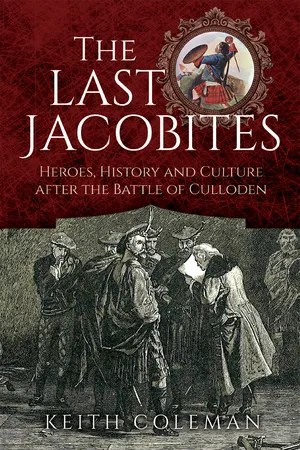
The Last Jacobites
Heroes, History and Culture after the Battle of Culloden
- 240 pages
- English
- ePUB (mobile friendly)
- Available on iOS & Android
About this book
For most people, the story of the Jacobites perished on a bitter April day in 1746 when their hopes of restoring the exiled Stuart monarchy at the battle of Culloden were crushed. Beyond this military defeat, which marked the end of the '45 rebellion, there were surviving embers who kept alive the cause for some time. For some years, Prince Charles Edward Stuart (Bonnie Prince Charlie) and his exiled supporters plotted with European powers to restore his banished house and regain the British throne, but there was never again a military attempt to oust the Hanoverians who displaced his lineage. In Europe, Jacobite networks flourished in France, but also in Scandinavia and were influential in spreading Masonic ideas in the areas they operated. Exiles joined the military as far afield as Spain and even Russia, while others formerly loyal to the cause found themselves in the New World, either banished by the British state or willing emigrants hoping for a better life. Ironically, most of the latter supported the British Empire and faced further hardship in the aftermath of the American War of Independence, finding themselves as losers in two major historic upheavals. Jacobitism arose again as a romantic ideal in the 19th century, surprisingly revived by the Hanoverian royal family, which had displaced the Stuarts. The cult of Highland Scotland was spearheaded by Queen Victoria, who saw herself as the embodiment and successor of the Jacobites. Towards the end of her reign, political Jacobitism became a fringe element in British politics energized Scottish nationalism and became an element in that country's artistic renaissance. The question of what Jacobitism means to different people in different ages is not an easily answered question. Even in its early days, the movement was not simply a political monarchist group devoted to restoration of a shattered dynasty. Its adherents and some of its detractors recognized some mysterious attraction in its ideals and its symbolism. Which other British royal cult survived so long and inspired a succession of Pretenders devoted to the doomed romance of a long-vanished line of monarchs?
Frequently asked questions
- Essential is ideal for learners and professionals who enjoy exploring a wide range of subjects. Access the Essential Library with 800,000+ trusted titles and best-sellers across business, personal growth, and the humanities. Includes unlimited reading time and Standard Read Aloud voice.
- Complete: Perfect for advanced learners and researchers needing full, unrestricted access. Unlock 1.4M+ books across hundreds of subjects, including academic and specialized titles. The Complete Plan also includes advanced features like Premium Read Aloud and Research Assistant.
Please note we cannot support devices running on iOS 13 and Android 7 or earlier. Learn more about using the app.
Information
Table of contents
- Cover
- Title
- Copyright
- Contents
- Author’s Note
- List of Illustrations
- Introduction
- Chapter 1 The Royal Stuarts
- Chapter 2 The Aftermath of Culloden
- Chapter 3 The Loch Arkaig Treasure
- Chapter 4 Executions and Atrocities
- Chapter 5 Hiding in the Hills
- Chapter 6 Exiles
- Chapter 7 The Ghost and the Red Fox
- Chapter 8 Dr Cameron and The Elibank Plot
- Chapter 9 The Jacobites and America
- Chapter 10 The Last Heirs: Henry and Roehenstart
- Chapter 11 Deaths and Rebirth
- Chapter 12 The Hanoverian Jacobites and the Nineteenth Century
- Chapter 13 Golden Afterglow
- Chapter 14 The Sobieski Stuarts
- Chapter 15 The Polish Connection and Other Overseas Stuarts
- Chapter 16 The Last Pretender
- Chapter 17 Outlanders and Others
- Epilogue: The Jacobite Hall of Mirrors
- Bibliography
- Plates